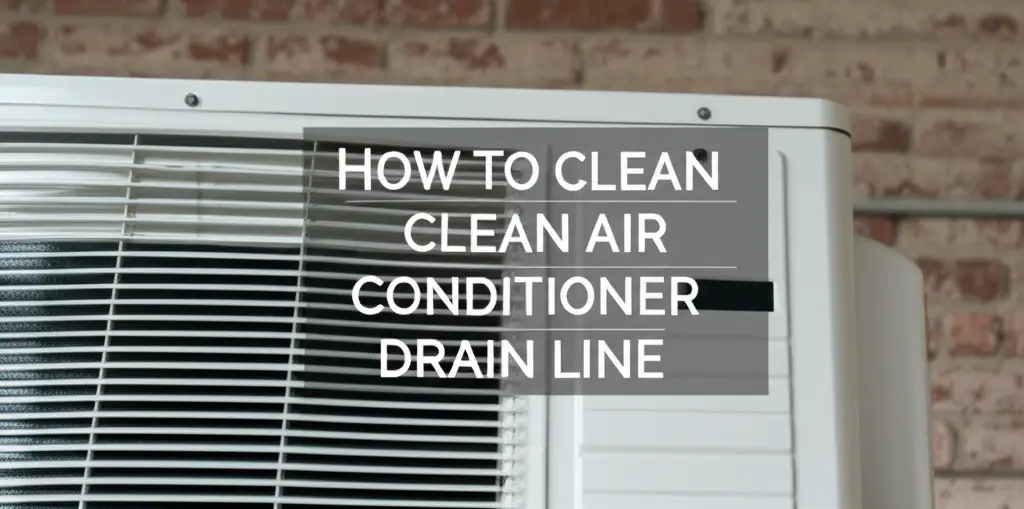· Cleaning Tips · 19 min read
How To Clean Air Conditioner Drain Line

How to Clean Your AC Drain Line: A Simple Guide
Is your air conditioner acting up? You might notice strange noises, reduced cooling, or even water pooling around the unit. These are common signs of a clogged AC drain line. Cleaning your air conditioner drain line is a vital part of home maintenance. It keeps your cooling system running smoothly. A clear drain line prevents water damage and mold growth. This guide shows you exactly how to clean air conditioner drain line yourself. We cover tools, safety, and step-by-step instructions. You will learn easy methods to tackle clogs. We also discuss how to prevent future issues. Let us make sure your AC works well all season long.
Takeaway:
- Regularly inspect your AC drain line for clogs and blockages.
- Use simple household items like vinegar or bleach for routine cleaning.
- Employ a wet/dry vacuum or air compressor for tougher clogs.
- Implement preventative measures to keep your drain line clear.
You clean an air conditioner drain line by flushing it with a mixture of vinegar and water or by using a wet/dry vacuum to suction out blockages. This process removes mold, mildew, and sludge that cause clogs, ensuring proper condensate drainage and preventing water damage or system malfunction.
Understanding Your AC Drain Line: Why It Clogs
Your air conditioner works by removing heat and humidity from your home. This process creates condensation, which is water. The AC unit collects this water in a drip pan. From the drip pan, a drain line carries the water outside. It might also lead to a floor drain. This drainage system is crucial for your AC’s operation.
A clean drain line ensures water flows freely. When the line gets clogged, water has nowhere to go. It backs up into the drip pan. This overflow can cause significant problems. You might see water leaks inside your home. These leaks can damage ceilings, walls, and flooring. Mold and mildew also grow in standing water.
The main culprits behind a clogged drain line are simple. Algae, mold, and mildew love damp, dark places. They grow inside the drain line. Slime builds up and traps dust, dirt, and debris. This creates a blockage. Insects or small rodents can also sometimes build nests in the outdoor end of the line. Understanding these causes helps you address the problem directly.
Preventing clogs starts with knowing what causes them. Regular cleaning breaks down these growths. It keeps the line open. A clear drain line means efficient AC operation. It protects your home from water damage. It also reduces the risk of mold issues.
Think of the drain line as a vital artery for your AC. If it gets blocked, the whole system suffers. This section helps you understand its importance. You will see why keeping it clean is a top priority. Knowing the enemy makes the fight easier.
Signs Your AC Drain Line Needs Cleaning
How do you know if your AC drain line is clogged? Your air conditioner often gives clear warnings. Paying attention to these signs helps you act quickly. Early detection can prevent more severe damage. Recognizing the symptoms saves you time and money.
One common sign is water leaking around your indoor AC unit. You might see puddles near the furnace or air handler. This water comes from an overflowing drip pan. It means the condensate cannot drain away. Do not ignore visible water leaks. They are a serious indicator.
Another sign is a musty or moldy smell. This odor often comes from mold or mildew. These organisms grow in the stagnant water. The smell circulates through your vents. It makes your indoor air quality worse. A foul smell suggests a blockage and water buildup.
Your AC might also stop cooling effectively. A clogged drain line can trigger safety switches. These switches shut down the unit. They prevent water damage. If your AC suddenly stops working, check the drain line. A safety shut-off often points to drainage issues.
Sometimes, you hear gurgling sounds. These noises come from the drain line. Air struggles to move past a blockage. It creates a bubbling sound. This sound is often faint. Listen carefully near the indoor unit. It indicates partial or full obstruction.
Finally, check the outdoor drain line opening. Sometimes, you see algae or slime. This visible growth indicates a buildup. It suggests the inner line also has problems. A simple visual inspection can confirm issues.
Recognizing these signs helps you diagnose the problem. A clogged AC drain line is a common issue. You can often fix it yourself. Knowing what to look for empowers you. It helps you keep your home comfortable and dry.
Essential Tools and Safety Precautions
Before you start cleaning your AC drain line, gather your tools. Having everything ready saves time. It makes the job smoother. You also need to prioritize safety. Working with electricity and water requires caution.
Here are the tools you will need:
- Wet/Dry Vacuum: This is very effective for suctioning out clogs.
- White Vinegar or Bleach: These help break down algae and mold.
- Funnel: For pouring liquids into the drain line.
- Gloves: Protect your hands from cleaning solutions and grime.
- Safety Glasses: Shield your eyes from splashes.
- Bucket or Towels: To catch any spilled water.
- Stiff Brush (optional): For scrubbing the drain pan.
- Garden Hose: For flushing the line after cleaning.
- Air Compressor (optional): For stubborn clogs, but use with care.
Safety comes first in any DIY project. Always turn off the power to your AC unit before working on it. Find your thermostat and set it to “off.” Then, go to your electrical panel. Locate the breaker for your AC unit and flip it to the “off” position. This prevents accidental startup. It protects you from electrical shock.
Wear your gloves and safety glasses. Cleaning solutions can irritate skin and eyes. Vinegar is mild, but bleach is corrosive. Avoid mixing bleach with other cleaners. Harmful fumes can result. Ensure good ventilation in your work area. Open windows or doors if possible.
Be careful when working with tools. Use a wet/dry vac correctly. Do not pull on wires or hoses aggressively. When using an air compressor, set it to a low PSI. Too much pressure can damage the line. If you are unsure, consult a professional.
Always be aware of your surroundings. Water can make surfaces slippery. Clean up spills immediately. Follow these precautions for a safe and effective cleaning experience. Your preparation ensures a job well done without incident.
Step-by-Step Guide: Cleaning Your AC Drain Line with Vinegar or Bleach
Cleaning your AC drain line is a straightforward process. You can use common household solutions like vinegar or bleach. Both are effective at breaking down mold and algae. Choose one method and follow these steps carefully.
Option 1: Cleaning with White Vinegar
White vinegar is a natural disinfectant. It is safer for your drain line than harsh chemicals. I prefer using vinegar because it is less aggressive. It still does a good job.
- Turn off the Power: First, always turn off your AC unit. Go to your thermostat and set it to ‘off’. Then, find your home’s circuit breaker box. Locate the breaker switch for your AC unit and flip it off. This prevents the unit from turning on during cleaning. Safety is paramount.
- Locate the Drain Line: Find the indoor unit of your AC system. This is usually the air handler or furnace. Look for a PVC pipe coming out of the unit. This is your condensate drain line. It typically exits through a small cap or opening.
- Find the Access Point: Many drain lines have a small T-shaped vent or access port. It will have a removable cap. This cap allows you to pour liquids into the line. If you do not see one, you might need to remove a section of the drain line. This happens less often.
- Clear Standing Water: If the drip pan is full of water, you need to empty it. Use a wet/dry vacuum to suck out the water. You can also use towels to soak it up. Remove as much water as possible from the pan.
- Pour Vinegar: Measure about 1/4 to 1/2 cup of plain white vinegar. Slowly pour the vinegar into the drain line access point. A funnel can help you avoid spills. Vinegar works to kill algae and mold.
- Wait for 30 Minutes: Let the vinegar sit in the line for at least 30 minutes. This gives it time to break down the clogs. For severe clogs, you can let it sit for a few hours.
- Flush with Water: After waiting, flush the drain line with a gallon of fresh water. You can use your garden hose for this. Pour it into the same access point. This washes away the dissolved grime. Check the outdoor end of the drain line to confirm water flow.
Option 2: Cleaning with Bleach
Bleach is a powerful disinfectant. It kills mold and mildew quickly. Use bleach with caution. Make sure to wear gloves and eye protection. Ensure good ventilation. For a more detailed guide on using bleach, refer to this article: How To Clean AC Drain Line With Bleach.
- Turn off the Power: Just like with vinegar, safety first. Turn off your AC unit at the thermostat and the circuit breaker.
- Locate the Drain Line and Access Point: Find the PVC drain line and its access point. This is the same location as for the vinegar method.
- Clear Standing Water: Remove any standing water from the drip pan. This ensures the bleach can directly reach the clog.
- Prepare Bleach Solution: Mix 1/4 cup of household bleach with 1/4 cup of water. Do not use full-strength bleach. It can be too harsh for some systems. Never mix bleach with other cleaners.
- Pour Bleach Solution: Slowly pour the diluted bleach solution into the drain line access point. Again, a funnel helps.
- Wait for 15-20 Minutes: Bleach acts faster than vinegar. Let it sit for 15 to 20 minutes. This time allows it to disinfect and break down clogs.
- Flush with Water: Flush the line with a gallon of clean water. Ensure the water flows freely from the outdoor end. If it does not, the clog might be too stubborn for this method.
After either method, turn the AC power back on. Monitor the system for a few hours. Check for leaks or continued issues. Most minor clogs clear up with these methods. These steps provide a solid approach to cleaning your AC drain line.
Advanced Cleaning Methods: Using a Wet/Dry Vac or Air Compressor
Sometimes, vinegar or bleach alone cannot clear a stubborn clog. This is when you need more power. A wet/dry vacuum or an air compressor can provide that extra force. These tools effectively remove persistent blockages. Use them with care and proper technique. They offer a strong solution for serious clogs.
Method 1: Using a Wet/Dry Vacuum
A wet/dry vacuum is excellent for suctioning out clogs. It pulls the blockage out rather than pushing it further in. I find this method very reliable.
- Turn Off AC Power: Always begin by turning off your AC unit’s power. Do this at the thermostat and the circuit breaker. This step is non-negotiable for safety.
- Locate the Drain Line Exit: Find the outdoor end of your AC condensate drain line. This is usually a small PVC pipe sticking out from your home’s exterior wall.
- Seal the Connection: Place the hose of your wet/dry vacuum over the end of the drain line. Create a tight seal. You can use duct tape or simply hold it firmly. A good seal ensures maximum suction power.
- Turn On the Vacuum: Switch on the wet/dry vacuum. Let it run for 2-3 minutes. You might hear gurgling sounds as it pulls out the clog. Be ready for dirty water, mold, or slime to come out. Have a bucket or old towels ready.
- Check for Flow: After vacuuming, go back to the indoor unit. Pour a cup of water into the access port of the drain line. Watch to see if it drains freely from the outdoor end. If it does, the clog is clear.
- Repeat if Necessary: If water still does not flow, repeat the vacuuming process. Sometimes, multiple attempts are needed for very stubborn clogs. You can also try flushing with vinegar after vacuuming for a complete clean.
Method 2: Using an Air Compressor
An air compressor can blast stubborn clogs away. This method requires more caution. Too much pressure can damage your drain line. I recommend using this only if other methods fail. For more details, consider reading How To Clean AC Drain Line With Air Compressor.
- Turn Off AC Power: Again, turn off the AC power at the thermostat and circuit breaker.
- Locate the Drain Line Access: Find the access point on the indoor drain line. This is often the T-shaped vent with a removable cap.
- Prepare the Compressor: Set your air compressor to a low PSI, generally 40-50 PSI. Do not exceed 60 PSI. Attach a nozzle that fits snugly into the drain line opening.
- Insert Nozzle and Blast Air: Insert the nozzle into the drain line access point. Create as tight a seal as possible. Give quick, short bursts of air. Do not hold the trigger down continuously. Short bursts prevent damage to the pipe joints.
- Check for Clog Removal: Go to the outdoor end of the drain line. Look for any expelled debris. You should see water and gunk come out.
- Flush with Water: After blasting, flush the line with a gallon of water. Pour it into the indoor access point. Confirm water flows freely from the outdoor end. If not, you may need to repeat the process carefully.
These advanced methods are powerful. They can clear even the toughest blockages. Always prioritize safety. If you feel unsure, a professional can help. A clear drain line ensures your AC works efficiently.
Preventative Maintenance for a Clear Drain Line
Cleaning a clogged AC drain line is necessary, but preventing clogs is even better. Regular preventative maintenance saves you hassle and money. It also extends the life of your air conditioner. Implementing a simple routine keeps your drain line clear. This ensures consistent cooling and avoids water damage.
Here are key steps for preventative maintenance:
- Regular Flushing: The easiest preventative step is regular flushing. Pour 1/4 cup of white vinegar into your AC drain line every 1-2 months. This helps kill algae and mold before they build up. Follow with a cup of clean water to flush it through. This simple act makes a big difference. It breaks down potential clogs before they harden.
- Keep the Outdoor End Clear: Regularly inspect the outdoor opening of your drain line. Make sure no leaves, dirt, or debris block it. Trim back any plants growing around it. A blocked exit point can cause water to back up. This leads to indoor clogs. Ensure the end is free and clear.
- Use Condensate Pan Tablets: You can buy special tablets designed for AC condensate pans. These tablets slowly dissolve. They release chemicals that prevent algae and slime growth. Place one or two tablets in your AC’s condensate pan every few months. Follow the product instructions for dosage and frequency. These are a great proactive measure.
- Change Air Filters Regularly: Dirty air filters restrict airflow. This can cause your AC coil to freeze. When the coil thaws, it produces excess water. This extra water puts more strain on the drain line. Change your air filters every 1-3 months. A clean filter helps maintain proper system function.
- Maintain Overall AC System: A well-maintained AC system is less likely to have drain line issues. Schedule professional AC tune-ups annually. Technicians clean coils and check drainage. They identify minor issues before they become major problems. This comprehensive approach keeps your entire system healthy.
- Check the Drain Pan: Periodically check your AC’s condensate drain pan. Look for standing water or visible slime. If you see buildup, clean it promptly. Use a stiff brush and a mild cleaning solution. This prevents the slime from entering the drain line.
- Monitor Humidity Levels: High indoor humidity can increase condensation. Use a dehumidifier in very humid climates. Reducing overall humidity lessens the load on your AC drain line. This helps keep it clearer.
By following these preventative steps, you significantly reduce the chance of clogs. A clear AC drain line contributes to a healthy home environment. It means efficient cooling and peace of mind. Consistency is key for effective prevention.
When to Call a Professional: Knowing Your Limits
While cleaning your AC drain line is often a DIY task, there are times when you should call a professional. Knowing your limits prevents further damage to your system. It also ensures your safety. Do not hesitate to seek expert help if you encounter specific issues.
Here are situations when you should consider calling a professional HVAC technician:
- Persistent Clogs: You have tried various cleaning methods. You used vinegar, bleach, a wet/dry vac, or an air compressor. The drain line remains clogged. This indicates a very stubborn blockage. It might be too far down the line. It could also be a solid object. A professional has specialized tools, like a snake or high-pressure flushing equipment.
- Water Leaks Continue: You cleaned the drain line, but water still leaks. This suggests the problem is not just a simple clog. The drain pan might be cracked. The drain line connections might be loose. Other components could be failing. A professional can diagnose the true source of the leak.
- AC System Not Working After Cleaning: After cleaning, your AC unit still does not turn on. Or it runs but does not cool. This points to a deeper system problem. A safety switch might have tripped. A sensor could be faulty. There might be an electrical issue. HVAC technicians can safely troubleshoot complex system failures.
- Damage During DIY Attempts: You accidentally damaged the drain line. Perhaps a pipe cracked. Maybe a connection came loose. Attempting repairs yourself might worsen the damage. Professionals have the parts and expertise to fix damaged components correctly.
- Unfamiliar with AC Components: You feel uncomfortable working with your AC unit. You are not sure where the drain line is. You do not understand how to safely turn off power. It is always better to be safe than sorry. HVAC systems are complex. Improper handling can lead to injury or costly repairs.
- Mold Infestation: You notice a significant amount of mold. It is not just in the drain pan. It is spreading to other parts of your AC system or ductwork. This requires professional mold remediation. They use specialized equipment and chemicals. They also ensure proper containment and cleanup. For advice on cleaning mold, you might find useful tips here: How To Clean Mold Around Air Vents or How To Clean Mold From Window Air Conditioner.
- AC Still Smells Musty: Even after cleaning, a musty odor persists. This suggests mold or mildew growth in other areas. It could be in the evaporator coil or ductwork. A professional can conduct a thorough inspection. They can clean the entire system.
- You Have a Mini-Split System: Mini-split AC units have specific drain line configurations. Cleaning these can sometimes be different. If you have a mini-split, consider checking specific guides for them, like How To Clean Mini Split Drain Line. If still unsure, a professional has experience with these units.
A professional HVAC technician has the training and tools. They can diagnose problems accurately. They can perform repairs safely and effectively. Investing in professional help saves you from bigger headaches later. It ensures your AC system operates efficiently.
FAQ Section
Q1: How often should I clean my AC drain line?
You should clean your AC drain line at least once a year. Doing it twice a year, especially before the cooling season and mid-season, is even better. Regular flushing with vinegar every 1-2 months prevents most clogs. This proactive approach keeps algae and mold from building up.
Q2: Can I use a chemical drain cleaner to clear my AC drain line?
No, you should not use harsh chemical drain cleaners in your AC drain line. These cleaners contain corrosive chemicals. They can damage the PVC pipes and fittings of your drain line. They can also harm your AC unit’s internal components. Stick to white vinegar, diluted bleach, or mechanical methods.
Q3: What if I don’t have an access port on my AC drain line?
If your drain line lacks an access port, you might need to cut the PVC pipe. Install a T-fitting with a removable cap. This creates a permanent access point for future cleaning. Alternatively, you can use a wet/dry vacuum from the outside drain line exit. This avoids cutting the pipe.
Q4: Will a clogged AC drain line damage my air conditioner?
Yes, a clogged AC drain line can damage your air conditioner. The overflowing water can cause rust and corrosion to internal components. It can also lead to electrical shorts if water reaches wiring. Most modern ACs have safety switches that shut off the unit. This prevents major damage. However, repeated shutdowns strain the system.
Q5: Can I prevent algae from growing in my AC drain line?
You can significantly reduce algae growth. Regular flushing with white vinegar is effective. Using condensate pan tablets designed to inhibit algae growth also helps. Ensure your AC unit’s outdoor drain line exit is always clear of debris. These steps combined keep your drain line clear.
Q6: How do I know if the clog is completely gone?
After cleaning, pour a gallon of water into the indoor drain line access point. Go outside and check the drain line exit. If water flows out freely and consistently, the clog is gone. Also, observe your AC unit for a few hours. Check for any signs of leaks or if cooling performance has improved.
Conclusion
Cleaning your air conditioner drain line is a fundamental part of home maintenance. It prevents costly repairs and keeps your AC running smoothly. We covered everything from understanding why clogs happen to performing advanced cleaning methods. You now know the signs of a clogged line. You also have the knowledge to select the right tools and techniques. Remember, a clear drain line means a comfortable home.
I encourage you to adopt a proactive approach. Regular flushing with vinegar prevents most clogs. Perform this simple task every few months. This saves you from future headaches and expensive service calls. If clogs persist or you feel uncomfortable, do not hesitate to call a professional. Your AC system is an important investment. Taking care of its drain line ensures its longevity and efficiency. Keep your drain line clear for consistent, effective cooling.
- AC maintenance
- clogged drain line
- air conditioner repair
- DIY cleaning
- condensate drain
- prevent leaks




